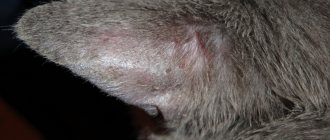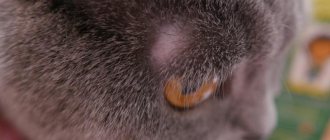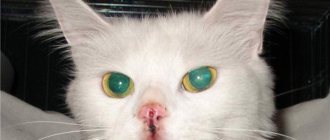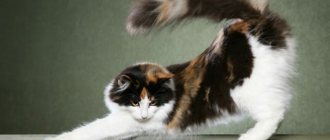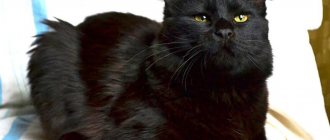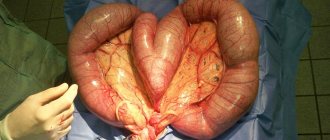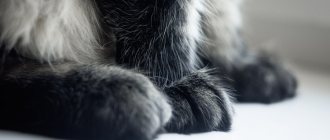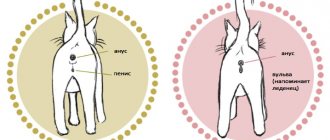(Be the first to vote!)
5589564
12/14/2021 owner reviews
We all know that cats shed, and that it's normal to have cat fur on your couch and clothes. However, it is important to know the difference between normal and abnormal hair loss. Thinning or hair loss in cats, also known as alopecia, on the back legs can be caused by a number of problems: fleas, allergies, bacterial infection or stress.
- Why do cats lose hair on their back legs? Fleas and other parasites
- Pain
- Allergies
- Stress and anxiety
Description of the problem
The structure of cat hair is not similar to human hair.
Unlike humans, most cats do not tend to go bald as they grow older. Despite periodic molting, they retain dense vegetation on their body even in old age. That is why the appearance of bald spots is always considered a pathology. The exception is hairless cat breeds. In these pets, the lack of hair on the body is a congenital feature.
Intense hair loss (alopecia) occurs in different areas of the body or can be symmetrical. The following areas are predominantly deprived of vegetation:
- stomach;
- back;
- lateral areas of the body;
- hips;
- hind legs;
- tail part.
Baldness in animals can be partial or complete. Most often, hair is lost during illness or as a result of reactions to negative stimuli. In some situations, a cat goes bald due to natural processes in the body.
In the presence of unfavorable factors, baldness can develop in both males and females. Most often, this pathology is observed in mature individuals and extremely rarely affects kittens.
Food allergy in cats: symptoms and treatment (photo)
Most often, a variety of food products act as allergens. Among them:
- sweets;
- bright vegetables and fruits;
- meat;
- dairy products (cottage cheese, sour cream, cream, etc.);
- eggs;
- corn.
At the same time, they can provoke irritation not only in their “pure” form, but also when they are part of dry food. For example, cheap economy-class products constantly contain cereals and vegetable cakes, as well as corn and harmful additives that can lead to an allergic reaction.
All cat owners should closely monitor the condition of their pets and stop thoughtlessly overfeeding animals with natural products and poor-quality “drying” at the first signs of deterioration in their pet’s well-being. Warning signals cannot be ignored. If you can't find the source of the problem on your own, go to the vet.
Symptoms of food allergies:
- wet eczema on the neck, abdomen, inner thighs;
- severe itching;
- discharge from the eyes and nose;
- in some cases, severe hair loss in the affected areas is possible;
- swelling of the larynx and difficulty breathing (if this symptom appears, urgent veterinary assistance is required).
The following treatment is possible, carried out exclusively under the supervision of a doctor:
Purpose of a special diet - the cat is transferred to a special food, all natural products are excluded from the diet.
Use of antibiotics as prescribed by a specialist.
Daily treatment of affected areas with special preparations that have a disinfectant and antimicrobial effect.
A bath with a special shampoo together with treating the animal against ectoparasites.
After completing the course of treatment, it is necessary to bring the animal back to see the attending physician. As a rule, after severe allergic reactions to natural food, the cat is switched to dry food, selected taking into account the individual characteristics of the body.
Only a doctor can tell you how to treat a cat’s allergies. Therefore, if your pet rubs against all corners and cannot find relief from the itching, and its skin is covered with wounds and begins to get wet, immediately go to an experienced veterinarian. Remember: the health of your beloved purr is in your hands.
Causes of baldness in cats
Hair loss in cats can be caused by various reasons. The violation may be caused by:
- Viral or bacterial infection.
- The fungus that causes ringworm.
- Cheyletiellosis associated with infection by a microscopic mite.
- Allergies caused by poor diet or contact with household chemicals.
- Hormonal imbalance that can occur in castrated or sterilized individuals.
- Constant stress that negatively affects the coat and the entire body.
In some cases, alopecia is caused by constant stress, oncology, chronic pathologies affecting the organs of the digestive system, and the presence of fleas in the pet. If a cat is going bald, the reasons may also be poor nutrition, which creates a deficiency of vitamins and minerals in the body, mechanical damage to the skin (burns, injuries associated with jumping, climbing trees, contact with sharp objects).
Baldness in a cat can be provoked by giving him medicinal injections. In this case, the hair becomes scanty directly at the injection sites. The cat's owner will not need to do anything. Gradually the vegetation will recover on its own.
Examination by a veterinarian and diagnosis
The effectiveness of treatment depends on an accurate diagnosis. As mentioned above, you should definitely contact a special clinic. Prescribing medications yourself is very dangerous. From such “treatment” the cat may lose all its fur.
At the veterinary hospital, your pet will be able to undergo the necessary examinations. One of the main tests is a trichogram. Thanks to it, they receive information about the condition of the coat, making the first conclusions about the causes of the disease.
To care for a cat, you need to know what a furminator is for, whether cats need clothes, everything about mating cats, how to choose a comfortable carrier, whether you need to sterilize a cat, how to trim a cat’s claws, how to make toys for a cat with your own hands, how to give birth to a cat how to make a scratching post.
Did you know? Smuggling cats from ancient Egypt was punishable by death.
Typical symptoms
Signs of developing alopecia are easy to detect even without veterinary education. The first symptom is thinning hair on the sides of the body, behind the ears, and in the tail area. Progressive pathology provokes the appearance of other characteristic signs:
- hair loss in large clumps;
- exposing areas of skin that acquire a pink or reddish tint;
- formation of unsightly crusts in areas affected by alopecia.
If your cat is going bald due to a serious medical condition, sores, scabs, or whitish bumps may form in the problem areas. The skin in the bald area sometimes becomes hot and loses its natural elasticity.
Many cats with alopecia become restless, experience constant discomfort, and avoid contact with their owners in every possible way. A cat may constantly lick and scratch hairless areas of the body, further injuring them.
With Itsenko-Cushing's disease, which affects cats in isolated cases, the animals not only go bald. Other symptoms are also observed - increased hunger and thirst, an increase in the size of the abdomen, and thinning of the epidermis.
What is flaking and how does it manifest itself in bald people?
Peeling is the formation of scales (squama), keratinized pieces of the epidermis. The separation of keratinized particles of the epidermis occurs constantly and is a normal physiological process, that is, the skin is renewed. With various skin diseases, this process intensifies. Scales can be separated either in very small (pityriasis-like) pieces or in plates. Depending on the underlying disease, the skin may be swollen, hyperpigmented, or, on the contrary, thin out and become almost transparent and reddish.
As we can see, flaking in Sphynx cats can be caused by a variety of factors, so it is necessary to make a diagnosis after a comprehensive examination of the cat. At home, if there are no other lesions on the skin besides peeling, you can try changing your skincare products and being more attentive to your cat’s hygiene. If there is no positive dynamics, try to make an appointment with a dermatologist. The doctors at our veterinary clinic will carefully examine your pet, perform a series of diagnostic tests to identify the cause of the flaking, and prescribe the optimal treatment.
Treatment depending on the cause
Treatment for alopecia becomes effective once its causes are correctly identified. It will be possible to establish the pathological factors that caused the disorder only after a detailed diagnosis.
If the cat begins to go bald, you will need to decide what to do together with your veterinarian. Before prescribing a course of treatment, the doctor will conduct a thorough examination of the pet and conduct a conversation with its owners. The following diagnostic methods will help you make a correct diagnosis:
- taking hair roots from the patient for subsequent examination under a microscope;
- general blood test;
- scraping from affected areas of the body;
- ultrasound or x-ray examination of internal organs (if the cat is suspected of having tumors).
The subsequent fight against the disorder is aimed at eliminating the underlying disease that provoked the thinning of the coat.
Treatment for a cat that is going bald is not quick and takes a considerable period of time. For successful hair restoration, all procedures must be done in accordance with the recommendations of a veterinarian. If the process is started, it is quite difficult to return the animal to normal coat.
What to do about baldness caused by infections
If the infectious nature of the disorder is confirmed, cats are prescribed:
- antiviral drugs (Kanamycin, Ribaflox);
- antibiotics (Amoxicillin, Ceftriaxone).
When affected by the fungus that causes ringworm, a combination of topical and internal agents is necessary. Sanoderm ointment, Mycostop ProVET spray, Orungal tablets, Ketoconazole are indicated for animals.
For cheyletiellosis, the main emphasis is on the use of skin preparations. It is possible to destroy parasites that cause thinning of the coat with the help of Ivermek spray, Demos, Butox.
In addition to the main treatment, you will need to enrich the cat’s menu with vitamins and bathe your pet often. Cat dishes and accessories and all rooms must be thoroughly sanitized. When affected by parasites, animals are cut short.
Combating allergies and hormonal problems
First of all, in case of baldness of allergic origin, all irritants must be identified and eliminated. Animals are prescribed anti-allergenic drugs:
- antihistamines;
- steroids;
- preparations with vitamin B 7.
The problem of a hormonal nature is eliminated with hormone-containing drugs. If a cat is going bald due to tumors in the thyroid gland, surgical intervention is prescribed.
The cat's diet includes lean boiled meat, fish, quail eggs, cereals, and vegetables. To prevent infection by parasites or food poisoning, you should carefully handle food and ensure its freshness.
What to do when your cat goes bald from stress
Cats that are going bald due to increased anxiety are prescribed sedatives. It is possible to improve the emotional background thanks to the following drugs:
- "Stop the stress."
- Relax Plus.
- "Zoomir Antistress".
- Fitex.
It will be necessary to normalize the situation in the house, to eliminate factors that traumatize the sensitive psyche of the animal. The cat needs to be provided with toys and places where it could hide in case of fear or stress.
It is important for cat owners to know what to do to prevent alopecia. Prevention of pathology includes a balanced diet of animals, vaccination, and periodic use of antiparasitic agents. Careful hygiene of cats, a favorable psychological climate in the house, and no contact with sick individuals are required.
Where do bald spots come from?
Alopecia is pathological hair loss in a specific area of the body.
Some cats have normal alopecia. For example, in the area from the eyes to the ears, hair grows there less often and owners often turn to the veterinarian on the topic: “my cat’s forehead is bald.” Pathological alopecia is one of the symptoms of dermatitis - inflammation of the skin.
- Allergy
- Skin and intestinal parasites
- Stress
- Hormonal disorders
- Infectious and fungal diseases
- Lack of some vitamins
So dermatitis can be considered a serious reason to visit the veterinarian, but for now let’s look at the existing diseases in more detail.
Allergic dermatitis
In fact, cats have terrible allergies. An allergy may be to:
- Chicken
- Pork
- Cereal feed components
- Cleaning agent
- Filler
- Drugs
And much more.
The allergy is manifested by severe shedding, ulcerations on the skin, scratching and restlessness of the cat. A runny nose and lacrimation appear for the second time.
Cats with allergies are prescribed medicated food for life. The most popular are the food from the Royal Canin and Hills line.
Skin and intestinal parasites
Skin fleas include fleas. They bite the animal and cause discomfort, and the cat begins to itch intensely. The hair follicles are injured from such pressure, and the hair falls out, and scratches appear on the exposed skin.
Fleas do not live on the cat itself, but only on the litter. But dark spots of bites are visible on the pet’s body. Favorite places for fleas are the chin, base of the tail and lower abdomen.
In the presence of internal parasites, cats do not tend to tear off their skin, but their fur falls out intensively. Simply because there are not enough nutrients for hair.
Treatment involves treating the cat for parasites.
Stress
A cat experiences severe stress if:
- A small child appears in the house
- Other animals appear in the house
- Moving
- Long road
- Going to the vet
The fur flies off the animal's body quickly and rapidly, and if nervous tension continues for a long time, then bald areas appear on its body.
Treatment: eliminate the stress factor. If for some reason this is not possible, then the cat is prescribed sedatives or anti-stress food.
Hormonal disorders
Causes of hormonal imbalance:
- Change of seasons
- Estrus
- Taking hormonal medications, for example, during estrus or to stimulate it
- Disorders of the pancreas, thyroid glands and adrenal cortex
- Long-term use of non-steroidal anti-inflammatory drugs
Treatment consists of restoring hormonal levels, but before this the animal goes through a long journey of various diagnostic manipulations.
Fungal diseases
The most famous fungus is lichen. It is widespread, and you can only get sick when your immune system is severely weakened. It appears as bald spots on the face, with redness and peeling of the skin.
Diagnosed by pointing a Wood's lamp at the affected area.
It is treated by taking antifungal agents on the skin itself and internally.
Consequences of injury
Observing a cat after it has fallen and been severely injured, you will notice that it has also lost a lot of hair on some parts of its body. Sometimes injuries are visible and easy to diagnose, but they can also be hidden, which is even more dangerous.
Hair loss is sometimes the only visible symptom of internal injuries. Therefore, having detected the appearance of alopecia after a fall of a pet, you need to immediately report this to the veterinarian observing the cat.
Bald spots in combination with fearfulness and wariness quite accurately indicate the stress the cat has experienced. With this state of psychological health, the pet does not want to be handled, does not allow itself to be petted, looks for secluded corners, and may flinch from sharp and loud sounds.
IMPORTANT! As you can see, bald spots on a cat’s body always indicate some kind of health problem, so this symptom cannot be ignored.
Preventive measures
Proper prevention often allows you to avoid problems with hair loss.
- You should carefully choose food for your pet, feed it not only dry food, but also high-quality homemade food (vegetables, dairy products, herbs). The diet should contain a lot of vitamins.
- Vaccination is required, taking into account the schedule for a specific breed.
- It is recommended to protect the cat from stress and injury and provide him with the best living conditions.
- Products for hair care and antiparasitic skin treatment are also needed.
Prevention
Problems when a cat has bald ears, belly, peeling heels, back or tail at the base arise quite often, but they are quickly treated. But in order not to injure the animal, violations should be prevented. To prevent the appearance of alopecia, veterinarians recommend monitoring the hygiene and nutrition of the animal. The cat must be kept in clean conditions so that it does not get infected. In order to identify violations in time, it is advised to regularly consult a doctor and independently check the condition of your pet’s skin. This will allow you to find out at the first stages of the development of the pathology why the fur is coming out and remove the disease. If hair falls out on the ears or the back becomes bald, you cannot treat it yourself, so as not to worsen the condition of your pet.
Diagnostic methods
After conducting an examination, the veterinarian will prescribe treatment according to the reasons that provoked the problem.
It is not recommended to self-medicate. As soon as your cat's fur begins to peel off, you should contact your veterinarian. He will conduct a series of studies to identify the cause of alopecia and prescribe therapy. First, the doctor learns about how the animal eats, where it lives and how often it goes outside. This helps to identify the source of the pathology. Next, he examines the cat, checking the condition of the hair using a microscope. The pet must undergo blood tests, hormone tests and scrapings to find out why the cat is bald and shabby. To identify the development of disorders of internal organs, it is necessary to do an ultrasound examination or radiography.
